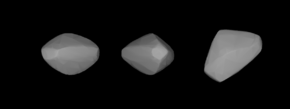43 Ariadne
 A three-dimensional model of 43 Ariadne based on its light curve | |
| Discovery | |
|---|---|
| Discovered by | N. R. Pogson |
| Discovery date | 15 April 1857 |
| Designations | |
| (43) Ariadne | |
| Pronunciation | /æriˈædniː/[1] |
Named after | Ariadne |
| Main belt (Flora family) | |
| Adjectives | Ariadnean, Ariadnian /æriˈædniən/ |
| Orbital characteristics | |
| Epoch 26 November 2005 (JD 2453700.5) | |
| Aphelion | 384.954 Gm (2.573 AU) |
| Perihelion | 274.339 Gm (1.834 AU) |
| 329.646 Gm (2.204 AU) | |
| Eccentricity | 0.168 |
| 1194.766 d (3.27 a) | |
| 101.582° | |
| Inclination | 3.464° |
| 264.937° | |
| 15.948° | |
| Physical characteristics | |
| Dimensions | 95 km × 60 km × 50 km[2][3][4] |
| Mass | (3.27 ± 1.35/0.59)×1017 kg[5] |
Mean density | 3.042 ± 1.255/0.547 g/cm3[5][a] |
| 0.2401 d[6] | |
| 0.274[7] | |
| S | |
| 8.8[8] to 13.42 | |
| 7.93 | |
| 0.11–0.025″ | |
43 Ariadne is a fairly large and bright main-belt asteroid. It is the second-largest member of the Flora asteroid family. It was discovered by N. R. Pogson on 15 April 1857 and named after the Greek heroine Ariadne.
Characteristics
Ariadne is very elongate (almost twice as long as its smallest dimension) and probably bi-lobed[4] or at least very angular. It is a retrograde rotator, although its pole points almost parallel to the ecliptic towards ecliptic coordinates (β, λ) = (−15°, 253°) with a 10° uncertainty.[3] This gives an axial tilt of about 105°.
Studies
43 Ariadne was in a study of asteroids using the Hubble FGS. Asteroids studied include (63) Ausonia, (15) Eunomia, (43) Ariadne, (44) Nysa, and (624) Hektor.[9]
Notes
- ^ Assuming a diameter of 59 ± 4 km.
References
- ^ Noah Webster (1884) A Practical Dictionary of the English Language
- ^ "IRAS Minor Planet Survey (IMPS)". Archived from the original on 11 December 2005. Retrieved 11 December 2005.
- ^ a b Kaasalainen, M.; Torppa, J.; Piironen, J. (2002). "Models of Twenty Asteroids from Photometric Data" (PDF). Icarus. 159 (2): 369–395. Bibcode:2002Icar..159..369K. doi:10.1006/icar.2002.6907.
- ^ a b Tanga, P.; et al. (2003). "Asteroid observations with the Hubble Space Telescope" (PDF). Astronomy & Astrophysics. 401 (2): 733–741. Bibcode:2003A&A...401..733T. doi:10.1051/0004-6361:20030032.
- ^ a b Fienga, A.; Avdellidou, C.; Hanuš, J. (February 2020). "Asteroid masses obtained with INPOP planetary ephemerides". Monthly Notices of the Royal Astronomical Society. 492 (1): 589–602. doi:10.1093/mnras/stz3407.
- ^ PDS lightcurve data Archived 14 June 2006 at archive.today
- ^ Supplemental IRAS Minor Planet Survey Archived 23 June 2006 at archive.today
- ^ "AstDys (43) Ariadne Ephemerides". Department of Mathematics, University of Pisa, Italy. Archived from the original on 27 March 2012. Retrieved 26 June 2010.
- ^ Tanga, P.; Hestroffer, D.; Cellino, A.; Lattanzi, M.; Martino, M. Di; Zappalà, V. (1 April 2003). "Asteroid observations with the Hubble Space Telescope FGS". Astronomy & Astrophysics. 401 (2): 733–741. Bibcode:2003A&A...401..733T. doi:10.1051/0004-6361:20030032. ISSN 0004-6361.
External links
- shape model deduced from lightcurve
- bi-lobed shape model from Hubble lightcurves [dead link]
- 43 Ariadne at AstDyS-2, Asteroids—Dynamic Site
- 43 Ariadne at the JPL Small-Body Database
